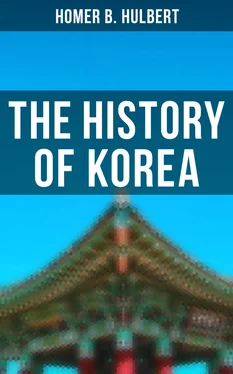Two years later the king Yu-ri of Ko-gu-ryŭ died and his son Mu-hyŭl ascended the throne, bestowing on his father the title Tong-myŭng or “Eastern Brightness.” The same year saw a remnant of the overthrown kingdom of Ma-han, under the leadership of Captain Chu-geun, attempt to wrest the scepter from Păk-je and restore the fallen house, but they were defeated and together with their wives and children were put to the sword. About this time an ancient royal seal was unearthed in northern Sil-la, where Kang-neung now lies. It became the royal seal of Sil-la.
The next year Ko-gu-ryŭ, ever on the lookout for aggrandisement, made the conquest of Pu-yŭ, the land from which Chu-mong had fled. The tradition is as follows. Ta-so the king of Pu-yŭ, had become possessed of a red crow with two bodies but only one head. The soothsayers said “Two countries will be joined under one head”. The king replied “Then it means that I shall conquer Ko-gu-ryŭ.” So he sent the bird to the king of Ko-gu-ryŭ as a gage of war, but that astute monarch replied “Red is the color of the south. I shall therefore conquer you.” Thereupon he took the initiative and sent a powerful army northward to make good his threat. The story says that as the army entered Li-mul forest the soldiers found swords clashing together but wielded by invisible hands. These they seized and hastened on. Soon they were joined by a gigantic warrior with a white face who joined their party and gave his name as Kwe-yu.
Approaching the capital of Pu-yŭ, they brought up at night before an extensive marsh. The Pu-yŭ king, thinking to surprise them by a night attack, attempted to cross the marsh, but became mired. The giant Kwe-yu dashed into the swamp and brought to the Ko-gu-ryŭ king his rival’s head. Upon this the Pu-yŭ forces surrendered; all but the brother of the fallen king who fled with a hundred followers and settled near the Ya-lu River, calling the place Kal-sa. This Ko-gu-ryŭ winked at.
In 24 A.D. the king of Sil-la died, having nominated as his successor not his son but Sŭk-t’al-hă his son-in-law. After the obsequies had been performed Sŭk-t’al-hă insisted that the prince assume the throne, but he in turn insisted that the dead king’s orders be followed. As a compromise Sŭk-t’al-hă proposed that they should find a man with sixteen teeth in his upper jaw, as this was a sign of unusual wisdom, and that upon him the throne should be bestowed. When it came to the test, it was found that the prince himself was the man. He could no longer refuse and ascended the throne under the title of Yi-sa-geum, or “Sixteen Teeth.” The present word In-gum which means “king” was doubtless derived from or is a corruption of this Sil-la word.
Meanwhile Ko-gu-ryŭ had been pushing her conquests steadily. Kă-ma and Ku-da, two northern districts or “kingdoms” were absorbed and other conquests were contemplated. The Emperor beheld these enlargements of Ko-gu-ryŭ with some concern and in 27 A.D. sent a strong force to bring her to terms. At the first encounter the forces of Ko-gu-ryŭ were routed and fell back toward the capital which, as we have seen, was then at or near the present town of Eui-ju. The king hastily summoned a council of war at which it was decided to man the walls of the capital and try to hold out until the enemy should be compelled by lack of food or the severity of the weather to raise the siege. The Chinese knew that there was little water within the wall and had high hopes of compelling a speedy surrender. This was all too true and there was soon much distress in the city; but a certain courtier said “If you will give me all the fish in the city I will undertake to make the enemy raise the siege or I will pay the penalty with my life.” He was given permission and soon he had the soldiers along the wall going through the motions of a bath, using fish scales for water. The scales glittered in the sun like drops of water and the enemy supposing that there must therefore be a good store of water in the city despaired of taking it by siege and so struck their tents and returned to China.
The marked difference between Ko-gu-ryŭ and Sil-la was well illustrated by the events of this year. While Ko-gu-ryŭ was reaching out covetous hands in every direction and carrying fire and sword into the hamlets of inoffensive neighbors, Sil-la was pursuing a course of such good will to all both without and within her borders that natives of the wild tribes to the north of her came in large numbers and settled on her soil, glad to become citizens of so kind and generous a land. The king himself made frequent tours of the country alleviating the distress of widows, orphans and cripples. It was in 32 B.C. that he changed the name of the six original families which united in founding Sil-la. The men of Yang-san, Ko-hŭ, Tă-su, Ul-jin, Ka-ri, and of Myŭng-whal were named respectively Yi, Ch’oé, Son, Chöng, Pă and Sŭl. These names will be recognised at once as among the most common patronymics in Korea at the present day, which adds confirmatory evidence that Korea of to-day is essentially the Korea of the south. When we add to this the fact that the names Pak, Kim, An, Ko, Sŭk, Yang, So, Sŭ, Kwŭn, Pă, Im, Na, Hyŭn, Kwak, Ho, Whang, Chang, Sim and Yu originated in southern Korea the argument becomes well-nigh conclusive. The only names of importance that did not originate in southern Korea are Min, Song, Om, Cho, and Han; and many of these originated in what must have been Ma-han territory. At the same time the king established seventeen official grades and called them respectively I-bŭl-son, I-ch’ŭk-son, I-son, P’a-jin-son, Tă-a-son, A-son, Kil-son, Sa-son, etc.
It must be remembered that as yet neither of the “Three Kingdoms” had begun to occupy all the territory that nominally belonged to it or that lay within its “sphere of influence.” Between them lay large tracts of land as yet unoccupied except by wild tribes. It is more than probable that at no point did any of these kingdoms actually touch each other. Ko-gu-ryŭ was broadening out northwards, Păk-je was at a standstill and Sil-la was growing rather by immigration than by occupation of new territory. As yet Sil-la had taken but four districts outside of the original six, and so we see that a large part of the south was still in the hands of the original inhabitants as given in the list of the settlements of the three Hans. In 41 A.D. the nine districts whose names ended in kan, namely A-do-gan, Yö-do-gan, P’i-do-gan, O-do-gan, Yu-su-gan, Yu-ch’ŭn-gan, Sin-ch’ŭn-gan, Sin-gwi-gan and O-ch’ŭn-gan, formed a confederacy and called it the “Kingdom of Ka-rak”. They placed their capital at Ka-rak, the present town of Kim-hă, and made Keum Su-ro their king. Tradition says that he obtained his Queen in the following way. A boat approached the shore bearing a beautiful woman, Queen Ho, whose ornamental name was Whang-ok or “Yellow Jade”. She came from the far southern kingdom of A-yu-t’a, otherwise known as Ch’ŭn-ch’uk. It is said that she lived a hundred and fifty-seven years and that the king survived her one year. All that is told us of the history of this rival of Sil-la is the list of her kings which will be found in the chronological tables. After an existence of 491 years it came to an end in the reign of the Sil-la king Pŭp-heung. It is also affirmed that when Sil-la fell in 935, some worthless wretches who defiled the grave of Keum Su-ro were mysteriously killed, one by the falling of a beam, one by an invisible archer and nine others by a serpent eighteen feet long. The records say that when the Japanese, at the time of the great invasion three centuries ago, dug open this king’s grave they found great store of gold and jade. The skull of the monarch was of prodigious size, and beside his body lay two women whose features were well preserved but which dissolved and melted away when exposed to the air. It is barely possible that we here have an indication that embalming was practiced, but if so we have no other intimation of it.
Читать дальше









